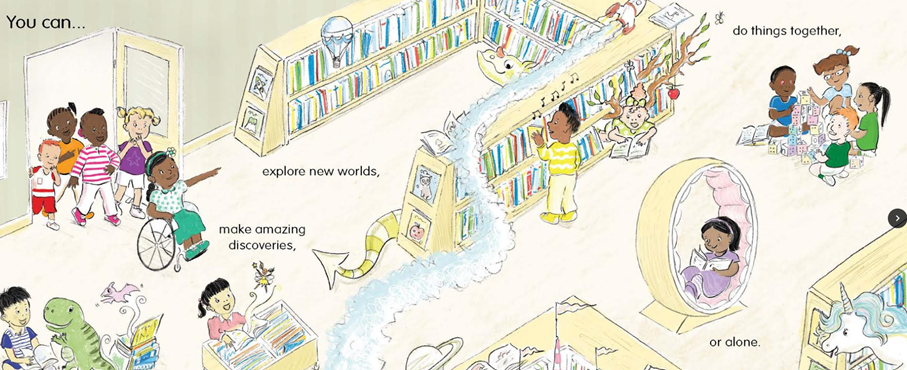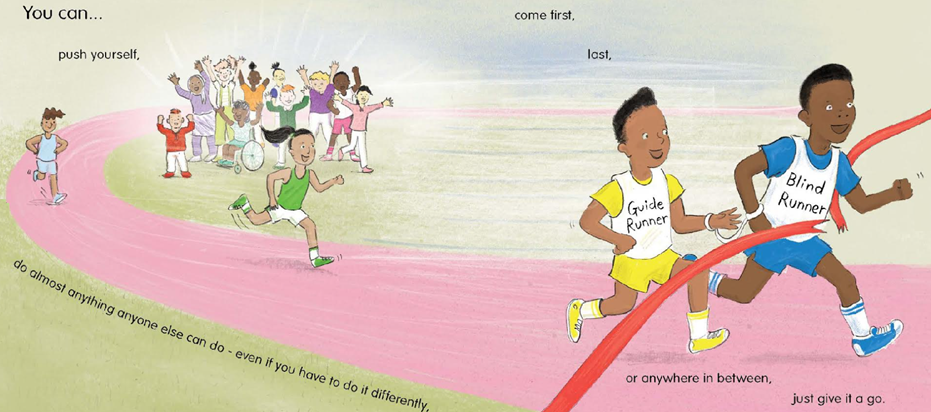You Can! A picture book about inclusion
Posted on Tuesday, November 9, 2021
Category: Book Blog
Alexandra Strick, co-founder of Inclusive Minds, tells us what inspired her new picture book, You Can!, illustrated by Steve Antony (Otter-Barry Books). You Can! encourages children to be brave, face challenges and overcome fears.
In this ReadingZone Blog, Alexandra tells us how the book developed to be truly inclusive and inspiring for children:
When I first started planning You Can!, I knew that I what I was trying to create was an empowering book which could resonate with all children. I wanted it to be inspiring, encouraging, reassuring, but in such a way that every child felt it was directly speaking to them. In short, I wanted to ensure that every child felt included, relevant, important, listened to.
Children's messages
In order to achieve that, the process needed to start by consulting children themselves, and then to continue to genuinely involve children throughout every stage of the book's development.
I collected ideas from a wide range of young people over a period of several years. I set out to discover which words of advice they would share with their younger selves, to help instil confidence and deal with inevitable bumps in the road. I kept reshaping and refining the wording, based on further feedback from young people, to ensure it was succinct and accessible and that every young person I spoke with found as many messages as possible that worked for them. It was a long process.
A new approach to illustration
Once the text was formed, however, it became clear that we had another challenge on our hands. The young people's messages were so far-reaching that there was a risk that a conventional approach to illustration might constrain or limit those messages. There were so many themes, so many interpretations, so many nuances in the children's words. And of course also different personalities, identities and backgrounds within the many young people we had consulted. The young contributors and I knew we wanted to reflect this. We wanted to give children as much as freedom as possible to interpret the words in their own way. Because of course different words mean different things to different individuals. So it was crucial that the illustrations didn't 'close' conversations but rather allowed children to add their own context, and find their own relevance. How could the illustrations reflect this?
It seemed an impossible task. I can only say thank goodness for the magic of Steve Antony! His was a truly ground-breaking solution. Where most picture books show a child (or perhaps a family) and generally across a brief period in time, his inspired plan was to show 14 different children' experiences. And we would see them growing up, year by year, spread by spread. So the first page of the book would show 14 babies and the final image as young adults. His idea was a stroke of genius, enabling the book to get so much across and so effectively and beautifully. However it was also highly ambitious, and meant another labour of love for the book.
Within the visual narrative, Steve successfully worked to include numerous subtle messages about how it's okay to change, to explore, to learn about yourself, to go through difficult times…essentially to be yourself, which of course is the overarching message of the book.

Prompting discussion through illustration
Yet the visual narrative also provides valuable prompts so it guides young readers, helping them to think beyond the most obvious meaning of each phrase. It sparks their thinking about how you can, for example, 'be clever' in different ways. To consider what 'be brave' might mean to you or how everyone can 'be beautiful'. How you can know your rights, be a good friend or make a difference in the world, even by doing something small. Steve's artwork manages to illustrate how some children might interpret the different messages whilst also leaving loads of space for every reader to consider what it means to them.
The book comments on things like the magic of books (we see fantastical creatures peaking through the bookshelves of the library), the pleasure of learning and practising and that joyous moment when you realise that you can now do something you couldn't do yesterday.

Highlighting inclusivity
One of the many key messages from young contributors in the text was the fact that sometimes we might need to do something slightly differently from other people. Steve's artwork illustrates this beautifully, with a blind runner in a race. Such incidental inclusivity was hugely important to us, so consultation with people with lived experience was crucial to ensure the details were authentic and accurate, such as the fact that the guide runner would run just a little behind the athlete. We ensured ongoing consultation with Inclusion Ambassadors from Inclusive Minds as an integral part of the book creation process, helping us form 'real' characters as well as checking practical things like what age a blind child might get a guide dog, what signs a Deaf children might use that would make sense in both British Sign Language and American Sign Language. We even looked into the almost 'subliminal' messages the book might give through its choices of colour and the potential stereotypes we could bust.
It was a huge learning process. Even though I've worked in the field of inclusion and equality for many years, this has actually just made me even more acutely aware that we are always learning, and we must always never lazily rely on guesswork and assumptions. We could not have created authentic representation without involving many, many 'experts by experience'.

How the characters change
Steve's revolutionary approach to illustrating this book also allows for discussions about how we change as individuals. His clever 'colour coding' of each child allows the reader to follow each character across each spread, and also see their personalities evolve. Much of the nuance might go unnoticed by the very young reader, but older children may see subtle but important comments on things like gender as a non-binary concept. I also love the way there are no adults present in the visuals - except on one crucial page, where the book reminds children that they can 'ask a grown-up for help'. This is such an important message - the children exploring the world for themselves, but adults always in the background when needed.
I'm very proud of what Steve and I have achieved with You Can, but also above all I am proud of the young contributors who shared their voices and experiences. And I really hope other children can share in that sense of ownership and empowerment.
It's a very honest book (the young contributors were insistent that the book needed to show that we all sometimes feel sad, experience loss, feel angry and make mistakes) but again, Steve's landscape shows that many such difficult moments are transient.
Above all, I hope children will find hope, comfort and positivity in the book, summed up so well in Steve's lovely endpapers showing that the babies have grown into young adults. And that they are doing what they love. This is such a reassuring message to leave children with.
And now more than ever, I think we could all do with feeling positive about the future and our ability to influence it.
You Can! (Otter-Barry Books) is available from all good bookstores (RRP £12.99)
